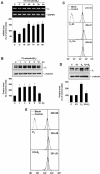Estrogen augments shear stress-induced signaling and gene expression in osteoblast-like cells via estrogen receptor-mediated expression of beta1-integrin
- PMID: 19821775
- PMCID: PMC3153398
- DOI: 10.1359/jbmr.091008
Estrogen augments shear stress-induced signaling and gene expression in osteoblast-like cells via estrogen receptor-mediated expression of beta1-integrin
Abstract
Estrogen and mechanical forces are positive regulators for osteoblast proliferation and bone formation. We investigated the synergistic effect of estrogen and flow-induced shear stress on signal transduction and gene expression in human osetoblast-like MG63 cells and primary osteoblasts (HOBs) using activations of extracellular signal-regulated kinase (ERK) and p38 mitogen-activated protein kinase (MAPK) and expressions of c-fos and cyclooxygenase-2 (I) as readouts. Estrogen (17beta-estradiol, 10 nM) and shear stress (12 dyn/cm(2)) alone induced transient phosphorylations of ERK and p38 MAPK in MG63 cells. Pretreating MG63 cells with 17beta-estradiol for 6 hours before shearing augmented these shear-induced MAPK phosphorylations. Western blot and flow cytometric analyses showed that treating MG63 cells with 17beta-estradiol for 6 hrs induced their beta(1)-integrin expression. This estrogen-induction of beta(1)-integrin was inhibited by pretreating the cells with a specific antagonist of estrogen receptor ICI 182,780. Both 17beta-estradiol and shear stress alone induced c-fos and Cox-2 gene expressions in MG63 cells. Pretreating MG63 cells with 17beta-estradiol for 6 hrs augmented the shear-induced c-fos and Cox-2 expressions. The augmented effects of 17beta-estradiol on shear-induced MAPK phosphorylations and c-fos and Cox-2 expressions were inhibited by pretreating the cells with ICI 182,780 or transfecting the cells with beta(1)-specific small interfering RNA. Similar results on the augmented effect of estrogen on shear-induced signaling and gene expression were obtained with HOBs. Our findings provide insights into the mechanism by which estrogen augments shear stress responsiveness of signal transduction and gene expression in bone cells via estrogen receptor-mediated increases in beta(1)-integrin expression.
Copyright 2010 American Society for Bone and Mineral Research.
Figures






Similar articles
-
Integrin-mediated expression of bone formation-related genes in osteoblast-like cells in response to fluid shear stress: roles of extracellular matrix, Shc, and mitogen-activated protein kinase.J Bone Miner Res. 2008 Jul;23(7):1140-9. doi: 10.1359/jbmr.080302. J Bone Miner Res. 2008. PMID: 18333755
-
Oscillatory flow-induced proliferation of osteoblast-like cells is mediated by alphavbeta3 and beta1 integrins through synergistic interactions of focal adhesion kinase and Shc with phosphatidylinositol 3-kinase and the Akt/mTOR/p70S6K pathway.J Biol Chem. 2010 Jan 1;285(1):30-42. doi: 10.1074/jbc.M109.010512. Epub 2009 Nov 4. J Biol Chem. 2010. PMID: 19889638 Free PMC article.
-
Fluid flow shear stress stimulates human osteoblast proliferation and differentiation through multiple interacting and competing signal transduction pathways.Bone. 2003 Mar;32(3):241-51. doi: 10.1016/s8756-3282(02)00979-1. Bone. 2003. PMID: 12667551
-
Mechanical strain regulates osteoblast proliferation through integrin-mediated ERK activation.PLoS One. 2012;7(4):e35709. doi: 10.1371/journal.pone.0035709. Epub 2012 Apr 23. PLoS One. 2012. PMID: 22539993 Free PMC article.
-
Bone morphogenetic protein 6 (BMP6) and BMP7 inhibit estrogen-induced proliferation of breast cancer cells by suppressing p38 mitogen-activated protein kinase activation.J Endocrinol. 2008 Dec;199(3):445-55. doi: 10.1677/JOE-08-0226. Epub 2008 Sep 9. J Endocrinol. 2008. PMID: 18780779
Cited by
-
Analysis of the Plasticity of Circulating Tumor Cells Reveals Differentially Regulated Kinases During the Suspension-to-Adherent Transition.Cancer Med. 2024 Oct;13(20):e70339. doi: 10.1002/cam4.70339. Cancer Med. 2024. PMID: 39425449 Free PMC article.
-
Targeting integrins to promote bone formation and repair.Nat Rev Endocrinol. 2013 May;9(5):288-95. doi: 10.1038/nrendo.2013.4. Epub 2013 Jan 29. Nat Rev Endocrinol. 2013. PMID: 23358353 Review.
-
Insulin augments mechanical strain-induced ERK activation and cyclooxygenase-2 expression in MG63 cells through integrins.Exp Ther Med. 2014 Jan;7(1):295-299. doi: 10.3892/etm.2013.1394. Epub 2013 Nov 8. Exp Ther Med. 2014. PMID: 24348809 Free PMC article.
-
Estrogen Receptor α Signaling in Osteoblasts is Required for Mechanotransduction in Bone Fracture Healing.Front Bioeng Biotechnol. 2021 Dec 7;9:782355. doi: 10.3389/fbioe.2021.782355. eCollection 2021. Front Bioeng Biotechnol. 2021. PMID: 34950644 Free PMC article.
-
Circulating microRNAs correlated with the level of coronary artery calcification in symptomatic patients.Sci Rep. 2015 Nov 5;5:16099. doi: 10.1038/srep16099. Sci Rep. 2015. PMID: 26537670 Free PMC article.
References
-
- Hillam RA, Skerry TM. Inhibition of bone resorption and stimulation of formulation by mechanical loading of the modeling rat ulna in vivo. J Bone Miner Res. 1995;10:683–689. - PubMed
-
- Hughes-Fulford M. Signal transduction and mechanical stress. Sci STKE. 2004;249:RE12. - PubMed
-
- Sikavitsas VI, Temenoff JS, Mikos AG. Biomaterials and bone mechanotransduction. Biomaterials. 2001;22:2581–2593. - PubMed
-
- Kapur S, Baylink DJ, Lau KH. Fluid flow shear stress stimulates human osteoblast proliferation and differentiation through multiple interacting and competing signal transduction pathways. Bone. 2003;32:241–251. - PubMed
-
- Pavalko FM, Chen NX, Turner CH, et al. Fluid shear-induced mechanical signaling in MC3T3-E1 osteoblasts requires cytoskeleton-integrin interactions. Am J Physiol. 1998;275:C1591–1601. - PubMed
Publication types
MeSH terms
Substances
Grants and funding
LinkOut - more resources
Full Text Sources
Research Materials
Miscellaneous

